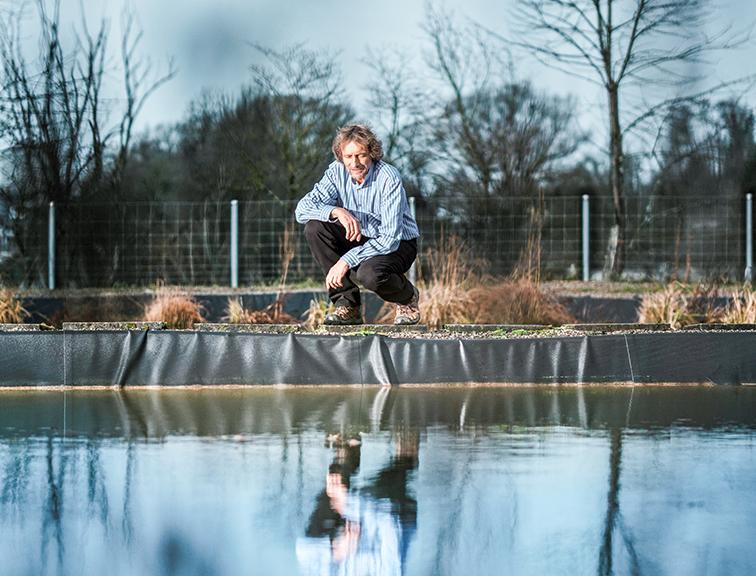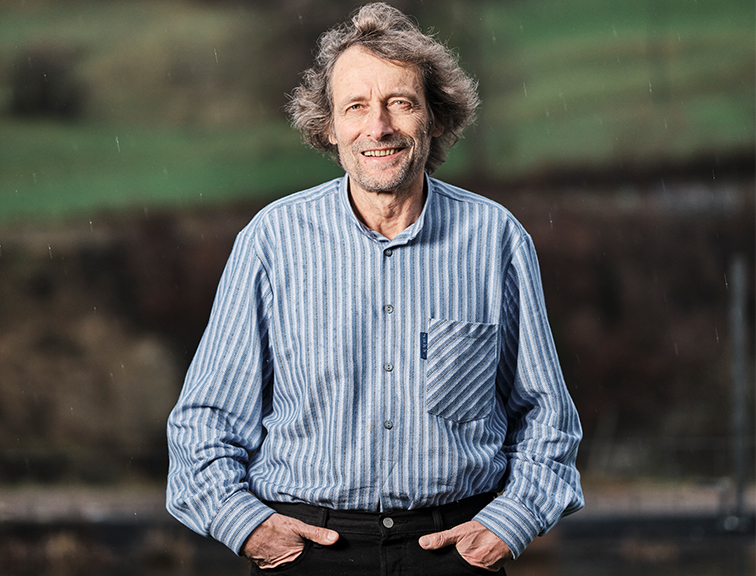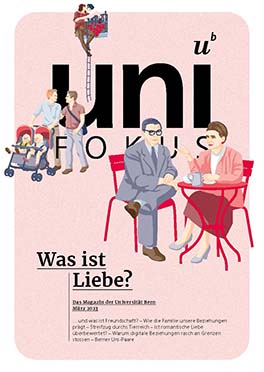Biology
Fit thanks to friends: Collaborating and benefiting
Real friends go through fire and flood for each other. How does this mutual care come about? A journey through the animal kingdom with behavioral ecologist Michael Taborsky shows that cooperation has its origins in biology.

Carrying boxes when your friend moves, watering plants while they are on holiday, providing comfort when they are heartbroken, cooking soup when they have the flu.
We are always there for our friends when they need us. We help “because we have a close social relationship that has been built up through emotional experiences,” says Michael Taborsky, Professor Emeritus of Behavioral Ecology at the University of Bern. We don’t expect anything in return for our favor. But we assume that at some point they will return the favor. Friendships and romantic relationships do not work (long) without mutual helpfulness – and for Michael Taborsky, who has been researching the evolution of cooperation in the animal kingdom for decades, it is undisputed that: “Human social behavior – and thus mutual aid – has its roots in biology. The basic mechanisms for altruism and its success are also found in the animal kingdom.” After saying that, he immediately introduces a species we tend to assume is not that friendly: the vampire bat.
They hunt at night and draw blood from vertebrates. Back at their sleeping place, they share their meal with friends when the latter return home unsuccessful and hungry: They always choke up a sip of blood for them.
Vampire bats cultivate a “circle of friends”, almost like we do: “First, they build up trust with alternating coat care before helping each other with blood donations,” says Taborsky, sometimes with one bat offering a portion, sometimes the other. This mutuality, a “tit for tat” relationship – also known as reciprocity – creates a win-win situation and ensures the survival of the small bloodsuckers. Because if a vampire bat doesn’t drink for two nights, it dies.
About the person
Michael Taborsky
has been Professor of Behavioral Ecology at the University of Bern since 2000 and researches the evolutionary principles underlying different behavioral strategies. He combines his studies on insects, fish, birds and mammals with theoretical and conceptual approaches. He has been emeritus since August 2020 and is now a fellow of the Wissenschaftskolleg zu Berlin.
The evolution of cooperation
Be it delousing chimpanzees, plumage-cleaning bull owls, nest-building field wasps: mutual help and cooperation are widespread among animals. But how could cooperative behavior develop in evolution? In the race for survival, you would only really expect to find egoists because, according to Darwin’s theory of evolution, only the fittest survive. Behavioral ecologist Taborsky explains: “Resources such as territory and food are limited. Animals have three ways to acquire and secure them: to be faster than the others, to monopolize them and to fight for them, or to cooperate and share.” There are certainly advantages to cooperation as a strategy: “Ultimately, the animals themselves benefit from their unselfish behavior, as we have seen with the vampire bat,” says behavioral ecologist Taborsky.

Benefit of kinship
But who is it worth making common cause with? For example, with relatives. Similar genes are a driving force for cooperative and altruistic behavior. For example, siblings of long-tailed tits and bee-eaters help raise each other's young. The self-sacrificing commitment to their fellow species is explained by kin selection, something defined by the Briton William Hamilton in the 1960s: In order to pass on its genes, an animal does not necessarily have to have offspring itself; it can also work for the survival of its siblings, with whom it shares half its genes – the same number as with its own offspring. “Sibling support occurs particularly when the environmental conditions are too adverse to reproduce themselves. In this situation, it is worth caring for the siblings and thus ensuring that genetic information for traits such as “sibling care” is passed on,” adds Michael Taborsky.
Brief explanation
Reciprocity
In biology, altruism refers to selfless behavior that increases the fitness of another creature, but reduces one’s own. When animals help each other, there is reciprocity: While aid costs initially, it increases the likelihood of receiving compensation later on. In direct reciprocity, I help the being who has helped me; in indirect reciprocity, I help the being who has helped others, and in generalized reciprocity, I help others because I have experienced help myself – it doesn’t matter who the help came from. According to Michael Taborsky, the experience of cooperation increases an individual’s willingness to help – something that can also be seen in humans: When we are helped, we are generally more helpful, even outside of our relatives and friends. A prerequisite for such generosity is the relatively low cost of such assistance and a “structured population” in which the social partners are likely to meet again at some point.
It’s buzzing in the beehive. The workers are eager to take care of the brood. They are wholly in the service of the state, where only the Queen reproduces. The workers are sterile and have no offspring.
The self-sacrifice of the workers is astonishing. The prime example of true altruism does not seem to make sense according to Darwin, who claimed that only those survive who also pass on their genes: If one individual completely refrains from procreation to the advantage of another, their genetic fitness due to the production of their own offspring is nil. So their characteristics don’t make it into the next generation – and the genes that are responsible for their selflessness die out. “Unconditional altruism, in which a giver never gets anything back or does not pass on their own genes, is an evolutionary dead end,” agrees Taborsky. Only a close look at the highly developed welfare state of the bees reveals the mystery surrounding the selfless workers: Here, too, kin selection is at work – after all, they are daughters of the only queen. The altruistic brood care can be explained by the fact that the bees raise their half or full siblings, with whom they share a large part of their genetic material. Similar relationships also exist in wasp states and ant colonies.

Cooperation deals for fish and rats
Relatives can count on each other, but vampire bats prove that cooperation also works among non-relatives. According to the principle of reciprocity, many other animal species also enter into “unrelated” aid deals. For example, the “Princess of Lake Tanganyika”, a highly social cichlid that Michael Taborsky has been studying for decades. The cichlids live in groups in which unrelated fish help the dominant breeding pairs to breed. “As a result, the subdominant brood care helpers have high metabolic costs, which actually slows their growth. In return, however, they buy the protection of the group, because if they were alone, they would immediately fall victim to predatory fish,” explains the biologist, detailing the trade between the fish, which in fact is not entirely voluntary either: “If a helper fish does not work the way it is supposed to, it is reprimanded by the breeding couple, threatened, rammed and, if necessary, even bitten.” Such asymmetrical cooperation, in which individuals are “forced to do good,” is widespread. Also in keas, a species of parrot from New Zealand, the dominant animal determines who procures the food.
“Every helpful action an individual takes increases the likelihood that they will also benefit later on.”
A rat pulls a board to the cage on a stick. As a result of the action, a rat in the neighboring compartment gets a portion of delicious oatmeal, but not the rat doing the work. The two animals are not related.
The scene comes from Taborsky’s laboratory at the Institute of Ecology and Evolution at the University of Bern. Together with his research team, he has spent many years studying the cooperative behavior of highly social migratory rats. In the wild, rodents live in groups of up to 200 individuals. They sleep next to each other, rub each other’s coat, exchange food, and are sometimes very friendly. With their experimental set-up, the researchers were able to show that the rats did not produce treats for every neighbor: The animals are predominantly generous towards those who have also shown generosity. The decision even depends on whether in the past they were given a fine banana or just a normal carrot. The rodents therefore accurately assess how cooperative a social partner is and behave accordingly reciprocally – or not, the rats that have been stingy often go empty-handed.
However, the willingness to cooperate within the group is generally high. Yes, a rat can also help a coworker if she has received food from another coworker. After all, “Every helpful action an individual takes increases the likelihood that they will also benefit later on,” says Michael Taborsky, “You can meet up again in the group at any time.” The rats recognize cooperative colleagues in the adjacent cage by their noses: “We were able to show that the animals can smell the “cooperation” signal,” says the researcher. The rodents can also detect the neediness of an animal, such as hunger, through the smell. “This happens via metabolites from metabolism that are excreted in their breath, and as it seems also via social pheromones.” This fragrance alerts the other rats, which in the experiment then procure food for the hungry conspecific. This increases their chances of being helped out later on if they themselves are in need.
Tit-for-tat preferably with friends
The examples show that: Being related is not a prerequisite for receiving help. On the contrary! Once again, the vampire bats astonish us with their behavior: “The probability of an animal giving blood to an unrelated individual is eight times higher than a relative being on the receiving end,” says biologist Taborsky – a phenomenon that is also evident in rats. What is initially astonishing soon becomes logical with his explanation: “Because of kinship, there is a certain willingness to help if necessary. But non-relatives have to make upfront investments in order to increase the chance of receiving support later on. Moreover, they have to fear they will go away empty-handed if they refuse the help needed. As a result: Non-relatives behave more generously.” And so vampire bats and rats rely more on friends than relatives to make the “tit-for-tat” work. Michael Taborsky sees parallels in this to humans: “Cooperation in the sense of mutual negotiation also takes place among people who are not related to each other.”
In other words, among friends carrying boxes for each other, taking dogs for walks, watering plants, carrying out all sorts of tasks.
New magazine uniFOKUS

Subscribe free of charge now!
This article first appeared in uniFOKUS, the new University of Bern print magazine. Four times a year, uniFOKUS shows what academia and science are capable of. Thematically, each issue focuses on one specialist area from different points of view and thus aims to bring together as much expertise and as many research results from scientists and other academics at the University of Bern as possible.
The online magazine of the University of Bern

Subscribe to the uniAKTUELL newsletter
The University of Bern conducts cutting-edge research on topics that concern us as a society and shape our future. In uniAKTUELL we show selected examples and introduce you to the people behind them – gripping, multimedia and free of charge.